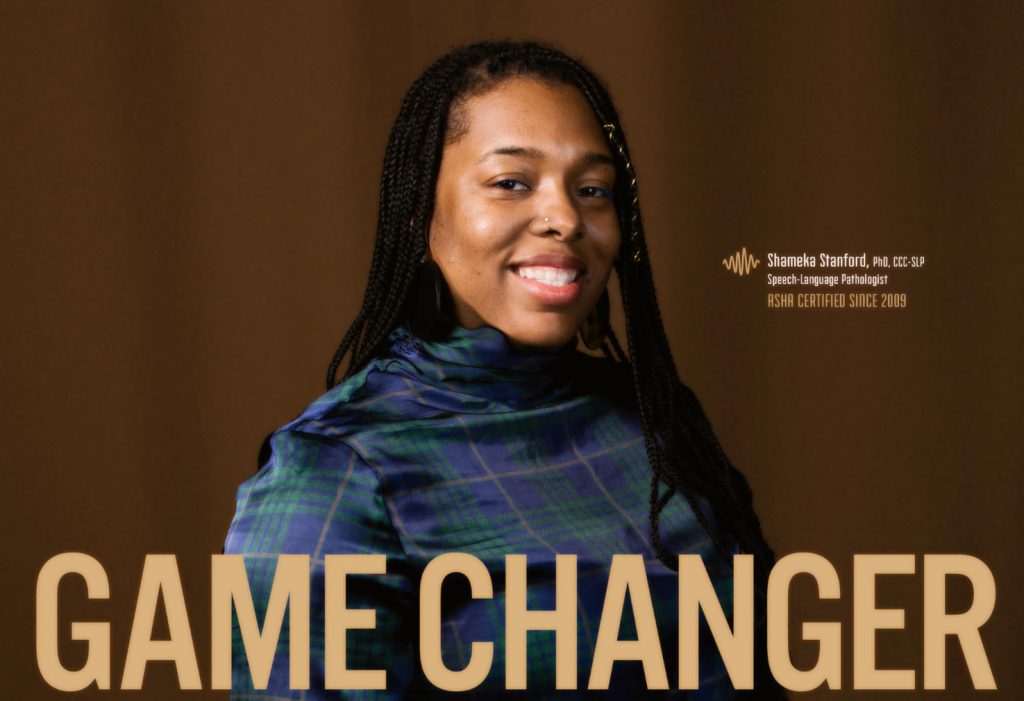Dr. Shameka Stanford, Ph.D., CCC-SLP/L
This article is a part of our “Elevating Underrepresented Voices” series. Our goal is to use our platform to help all speech-language professionals learn about the issues facing our profession when it comes to underrepresented populations. Please click here to see what other SLPs we have featured.

Dr. Shameka Stanford, PhD, CCC-SLP/L
Dr. Shameka Stanford is a Professor in the Communication Sciences and Disorders department at Howard University and the Juvenile Forensic Speech-Language Pathologist. Dr. Stanford is the first and only Juvenile Forensic SLP in the United States and she specializes in Juvenile Forensics, Law Enforcement Interaction with youth with CD, and child language disorders. Her research focuses on the Confluence and Impact of cognitive and communication disorders on the school-to-confinement pipeline, status offenses, involvement with the criminal justice system, law enforcement interaction, and criminal recidivism in youth placed at-risk for delinquency and crime (especially Black and Brown youth from under-resourced areas). Dr. Stanford is also a clinically certified and licensed speech-language pathologist and is licensed to practice in Maryland, Washington, D.C, and North Carolina. Through her work, Dr. Stanford has created cutting edge social justice and juvenile justice specialty courses for graduate CSD students, nationally known training programs for law enforcement and legal counsel, and national and international CE workshops and training for licensed SLP clinicians.
Quote: “Your greatest Juvenile Justice Experts are the Youth… Utilize and include them in the discussion, they are our best resources.” – S. Stanford
Learn More from Dr. Stanford:
We at The SLP Solution are incredibly fascinated by this area of our profession that we weren’t even aware was being studied. We thank Dr. Stanford for helping us to learn more about how cognitive and communication disorders can impact Black and Brown youth from under-resourced areas. Here are some more resources to learn more about this issue:
THE CONFLUENCE OF LANGUAGE AND LEARNING DISORDERS AND THE SCHOOL-TO-PRISON PIPELINE AMONG MINORITY STUDENTS OF COLOR: A CRITICAL RACE THEORY
By: Shameka Stanford, Ph,D., CCC-SLP/L and Bahiyyah Muhammad
Quote: “As a result, students in special education—especially those who are African American and living with an undiagnosed and untreated language and learning disorder—have a higher school drop-out rate and enter society with significantly higher incarceration rates than their peers of other races.”
By: Shameka Stanford, Ph,D., CCC-SLP/L
Quotes:
“There is a scarcity of research that explicitly explains the development of the brain in youth with language and learning disorders who come into contact with the criminal justice system. Due to their increased vulnerability to tactics used to elicit admission, this may be one reason why they are overrepresented in the coercion of false confessions.”
“…when interrogating individuals with language and learning difficulties, especially youth, we need to replace police interrogation tactics with more neutral techniques that support their language and learning abilities. Such as, determining explicit comprehension of rights prior to beginning interrogation, simplifying terminology commonly used in police interactions, avoiding ambiguous terms that may be misinterpreted to mean other things, and determining the ability to functionally answer WH-questions (what, where, who, why, and how), and verbally express themselves at an age-appropriate level.”
Casualties of Misunderstanding: Communication Disorders and Juvenile Injustice
By: Shameka Stanford, Ph,D., CCC-SLP/L
Quotes:
“The problems often begin with zero-tolerance policies, in which schools hand down swift and severe punishment—suspension, expulsion or placement in juvenile detention—for student misconduct. More than 80% of young people affected by these policies were found to have a CCD, a learning disability, or some combination of these, according to a 2018 article on CCDs and the school-to-prison pipeline in the Journal of Gender, Social Policy and the Law.“
“As it stands, psychologists and forensic social workers are typically the professionals who address communication disorders among incarcerated youth. It is time to distinguish communication disorders from mental illness in the juvenile justice system—and to bring in more SLPs.”
Connect with Dr. Stanford:
Want to learn more? Would you like to connect with Dr. Stanford? Here’s how:
The Juvenile Forensic SLP on Instagram
Follow Dr. Stanford’s Instagram to learn more. Also, check out the link in her profile for more articles and resources on this subject.
Visit Dr. Stanford’s profile at Howard University.



